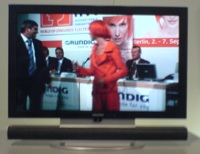 As with all companies at IFA, Grundig have shown a ton of new products, try to persuade the assembled throngs that they are approaching Digital Lifestyles by understanding the consumer.
As with all companies at IFA, Grundig have shown a ton of new products, try to persuade the assembled throngs that they are approaching Digital Lifestyles by understanding the consumer.
It was all very much of a muchness, until they started talking about 3D TV … everyone in the room lent forward a little. Would this be for real or not. We learnt that it wasn’t the 3D that needed red and green glasses that give you a headache, but was to be viewed with the naked eye.
Working with X3D technologies, 3D Image Processing and Cobalt Entertainment (who make the camera), the result are shown on a standard LCD TV Tharus 30 with a special filter, provided by X3D Technologies, fitted to the front. The clever stuff is performed by 3D Image Processing’s (3D-IP) Black Betty box, which generates 8 different views of the 2 pictures recorded by the camera, jiggles them around and displays them in 3D in real time.
Back to the demo … Miss IFA (the shows red-haired icon) is called forward to demonstrate.
The special 3D camera was unveiled, as were the monitors covered with black-out cloths. Argh … the displays showed fractured moving images striped vertically down the screens. Tech wiz Steve was called forward to carry out emergency turning to the display unit, while the demonstrator started to sweat, explaining that it had worked for the 20 times they had tried it this morning. The black cloths were placed back on the screen to hide the embarrassment.
A couple of button presses later and Steve announced it was ready.
The room, slightly less believing waited.
As the monitors were revealed, the 3D TV was seen and the room was impressed. The ideal viewing distance of 4m was soon compromised as people eagerly clambered over each other to get a view.
It’s impressive, with the subject that is nearest to the camera actually appearing forward of the rest of the image in shot.
Grundig plan to release the first content on disc – as soon as the cameras have been used to shoot anything. The rumors are George Lucas is already preparing some of Star Wars for 3D broadcast.
Oh and if you want to impress your geeky mates, you can call the screen a ‘auto-stereoscopic multi user display’, and that’s official.
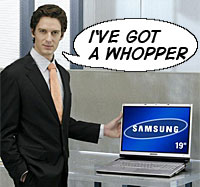 Samsung will be debuting the world’s first 19″ notebook, the Samsung M70, on 2 September at the IFA Consumer Electronics Show in Berlin.
Samsung will be debuting the world’s first 19″ notebook, the Samsung M70, on 2 September at the IFA Consumer Electronics Show in Berlin.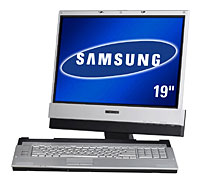 This lets users detach the laptop’s screen and place it in a dock to give the appearance of a conventional desktop.
This lets users detach the laptop’s screen and place it in a dock to give the appearance of a conventional desktop.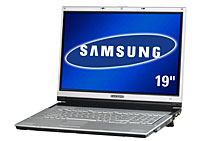 Despite the added complexity and enormous screen size, Samsung have claimed that the laptop will weigh no more than their current 17-inch notebook so it should be vaguely portable (if you work out at the gym).
Despite the added complexity and enormous screen size, Samsung have claimed that the laptop will weigh no more than their current 17-inch notebook so it should be vaguely portable (if you work out at the gym).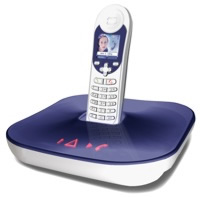 The acceptance of VoIP into the mainstream moved up a gear today with the release of a DECT VoIP handset, the plain-badly-named EV5203-C, from Thomson, the _huge_ French all-encompassing media company. The product is the first fruit from Thomson’s purchase of Inventel, earlier this year.
The acceptance of VoIP into the mainstream moved up a gear today with the release of a DECT VoIP handset, the plain-badly-named EV5203-C, from Thomson, the _huge_ French all-encompassing media company. The product is the first fruit from Thomson’s purchase of Inventel, earlier this year. It can be a confusing life for protesters keen to voice their opinions at the G8 meeting in Gleneagles.
It can be a confusing life for protesters keen to voice their opinions at the G8 meeting in Gleneagles.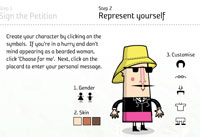
 All those signing up will have their names added to the online petition, the Live 8 list, which is being sent directly to the G8 leaders.
All those signing up will have their names added to the online petition, the Live 8 list, which is being sent directly to the G8 leaders.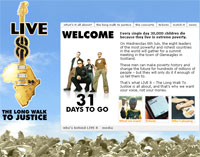 AOL has announced it will broadcast the Live 8 concerts in London, Philadelphia, Paris, Rome and Berlin online for free.
AOL has announced it will broadcast the Live 8 concerts in London, Philadelphia, Paris, Rome and Berlin online for free. Geldof boomed: “The G8 leaders have it within their power to alter history. They will only have the will to do so if millions of people show them that enough is enough.”
Geldof boomed: “The G8 leaders have it within their power to alter history. They will only have the will to do so if millions of people show them that enough is enough.”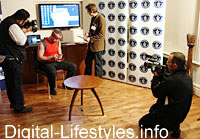 Digital-Lifestyles were on hand to witness a new world record being created, as former World Text Champion Arttu Harkki used a Treo 650 smartphone to type the fastest-ever email on the move using a QWERTY keyboard – using a single thumb.
Digital-Lifestyles were on hand to witness a new world record being created, as former World Text Champion Arttu Harkki used a Treo 650 smartphone to type the fastest-ever email on the move using a QWERTY keyboard – using a single thumb.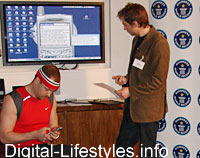 Before the record attempt could start, Hein Le Roux, official adjudicator from Guinness World Records explained the rules, “There are a lot of phones that incorporate QWERTY keyboards, and we need to make sure that the record is standard across all models. For this reason, we asked Arttu Harkki to type using just the thumb of one hand.”
Before the record attempt could start, Hein Le Roux, official adjudicator from Guinness World Records explained the rules, “There are a lot of phones that incorporate QWERTY keyboards, and we need to make sure that the record is standard across all models. For this reason, we asked Arttu Harkki to type using just the thumb of one hand.”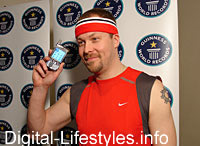 As the stopwatch-toting Le Roux looked keenly on, Harkki’s mighty uni-thumb went supernova as he bashed out the following message:
As the stopwatch-toting Le Roux looked keenly on, Harkki’s mighty uni-thumb went supernova as he bashed out the following message: Once I’d recovered from the high octane excitement of watching someone write a text message repeatedly, I asked Le Roux what the previous record had been, and was surprised to find that there hadn’t been one, because this was a new category.
Once I’d recovered from the high octane excitement of watching someone write a text message repeatedly, I asked Le Roux what the previous record had been, and was surprised to find that there hadn’t been one, because this was a new category.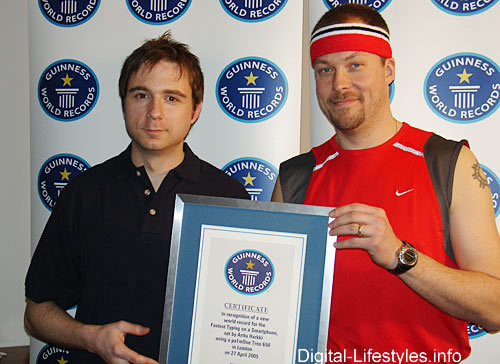
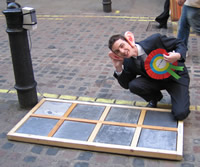 Living Streets, a national charity, launched its election campaign, “Talk to me about streets”, by making street items like paving and signs talk back to passers-by in Meard Street, Soho, London.
Living Streets, a national charity, launched its election campaign, “Talk to me about streets”, by making street items like paving and signs talk back to passers-by in Meard Street, Soho, London. Paving ‘squealed’ underfoot to point out the dangers of tripping over broken paving while spooky whispering windows resonated with the sound of absent children, no longer able to play in our dangerous streets.
Paving ‘squealed’ underfoot to point out the dangers of tripping over broken paving while spooky whispering windows resonated with the sound of absent children, no longer able to play in our dangerous streets.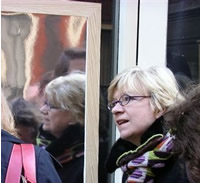 Living Streets Director Tom Franklin explains, “The streets are the one public service that everyone uses. Politicians can directly improve people’s daily lives by improving the street environment.”
Living Streets Director Tom Franklin explains, “The streets are the one public service that everyone uses. Politicians can directly improve people’s daily lives by improving the street environment.”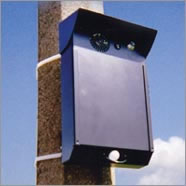 Verity Parker, who is doing an PhD at Brunel investigating electrical conductive fabrics, worked with Stock Displays to produce talking street signs, labelled in standard UK form, but with short audio samples.
Verity Parker, who is doing an PhD at Brunel investigating electrical conductive fabrics, worked with Stock Displays to produce talking street signs, labelled in standard UK form, but with short audio samples.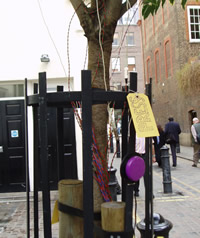 ‘The street that talks’ has the support of the Royal National Institute of the Blind, (RNIB) which also campaigns for streets and the built environment to be more accessible to blind and partially sighted people.
‘The street that talks’ has the support of the Royal National Institute of the Blind, (RNIB) which also campaigns for streets and the built environment to be more accessible to blind and partially sighted people. An accompanying new Living Streets’ pamphlet – written by two of Britain’s most eminent architects, Lord Richard Rogers and Sir Terry Farrell – was also unveiled at the event.
An accompanying new Living Streets’ pamphlet – written by two of Britain’s most eminent architects, Lord Richard Rogers and Sir Terry Farrell – was also unveiled at the event.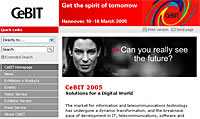 The world’s leading technology tradeshow, CeBIT, starts this Thursday in Hannover, north Germany with pundits expecting the show to reflect the recent stellar growth in the $2 trillion technology industry.
The world’s leading technology tradeshow, CeBIT, starts this Thursday in Hannover, north Germany with pundits expecting the show to reflect the recent stellar growth in the $2 trillion technology industry. As VoIP (Voice over Internet Protocol) continues to gain in popularity, there’ll be dozens of companies showcasing devices to make free calls as well as displays of corded and cordless Skype phones by Siemens, Motorola, Good Way Technologies and Greatwall Infotech.
As VoIP (Voice over Internet Protocol) continues to gain in popularity, there’ll be dozens of companies showcasing devices to make free calls as well as displays of corded and cordless Skype phones by Siemens, Motorola, Good Way Technologies and Greatwall Infotech.
 The two companies worked for several months to integrate the software with the handsets and have provided a solution that will, in some circumstances, enable calls made over GSM and GPRS technology to be free, while others will be subject to small charges.
The two companies worked for several months to integrate the software with the handsets and have provided a solution that will, in some circumstances, enable calls made over GSM and GPRS technology to be free, while others will be subject to small charges.